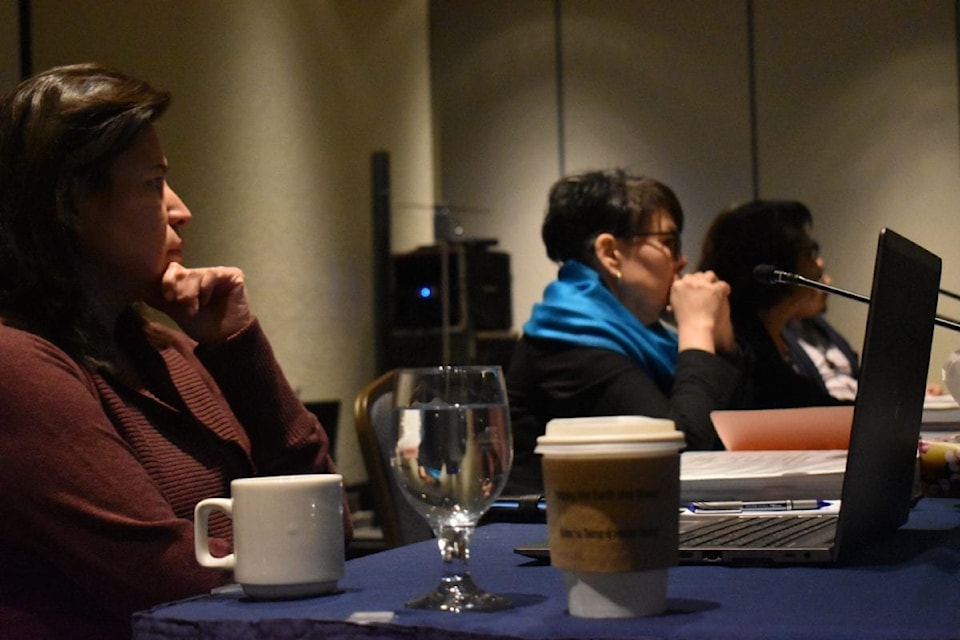It was a sign of things to come as De Beers Canada defended plan to close the Snap Lake mine to the Mackenzie Valley Land and Water Board this week.
Fielding questions in an Explorer Hotel conference room Tuesday and Wednesday, De Beers representatives pushed back against a suggestion by the Government of the Northwest Territories (GNWT) suggestion that the company’s estimates of environmental impact on the lake were off.

Nick Pearce /NNSL photo
Representatives also remarked that investors were watching how regulators handled the situation as an aging industry prepares for other closures.
Related coverage:
EXCLUSIVE: De Beers hints at longer life for Gahcho Kue
De Beers diamond sales down 39 per cent
“Many people are watching what is rolling out in this hearing. Because, yes, this is the first of several diamond mines that will be closing in the future,” Erik Madsen, lead of corporate affairs Canada for De Beers, said in his closing statements Wednesday afternoon.
In that economic climate, Madsen described investors as wondering if will face “conditions that are not evidence-based, not easily achievable, and could impose undue financial burden.”
The reclamation plan
De Beers closed Snap Lake in December 2015, when the firm determined the troubled underground mine 220 kilometres northeast of Yellowknife was no longer viable.
It submitted its final closure plan for the site to board in March, costing roughly $85 million. With its current license set to expire next year, this week it went before the Board to renew its water license necessary for carrying out that plan.
Projected to start in 2021, the plan comes in two phases.
The first runs eight years, at which time “mine facilities will be decommissioned or demolished, water management systems will be adapted for closure, and the land will be reshaped and revegetated,” the plan submitted in March states.
The next phase runs at least 10 years and involves monitoring monitoring the mine to see if it’s meeting its closure goals “and ensuring the successful long-term closure of the site," the plan states.
‘The cost when this goes wrong’
At the meetings, Northwest Territories government officials questioned the accuracy of De Beers’ water modelling, and the potential impact of effluent. Both the federal and territorial government recommended tighter limits.
Resident Todd Slack also voiced his concern at the public hearing.
“The point I’m trying to make here is there are going to be a lot of predictions and a lot of modelling here. All of which is inherently going to be wrong. (But) it’s not necessarily going to be wrong to the same degree,” he said, explaining he found it helpful to be cautious.
In this experience, he said there was a level of certainty that the evidence didn’t support. “When I hear again the project is certain of what’s going to happen. I think (we) should be approaching this with a level of concern and skepticism,” Slack said.
According to Slack, there were also different motivations at play in the meeting. Northwest Territories was attending the meetings to represent all citizens’ interests, though it may not always be necessarily right. He compared this to a firm whose aim is “to try to reduce their securities, to try to have lower limits, to try to make it easier for them to walk away from this site.”
“We as a citizenry, know the cost when this goes wrong,” he said, adding that the board should be cautious moving forward.
De Beers responds
In closing remarks to the Board, Erik Madsen defended the diamond giant’s “robust” closure plan.
Madsen warned that delaying approval would hinder the closure of the site, and further cool investors’ attitudes to the Northwest Territories. He pointed to October’s Territorial election, where several candidates expressed concern over the future of NWT’s diamond industry.
Upping investor confidence emerged as a priority, he said, adding that the Board “had a role to play in this.”
Existing needs have been met and the “water remains good to drink and the fish good to eat in Snap Lake and beyond,” Madsen said, arguing that there had been no evidence presented to the contrary. According to him, the De Beers plan responsibly managed effluent levels.
Madsen added government argued to place to place tighter limits on De Beers because it thought the company could reach them, not because of risk to the environment.
“Stricter limits will not result in improved environmental outcomes for Snap Lake,” Madsen said.
